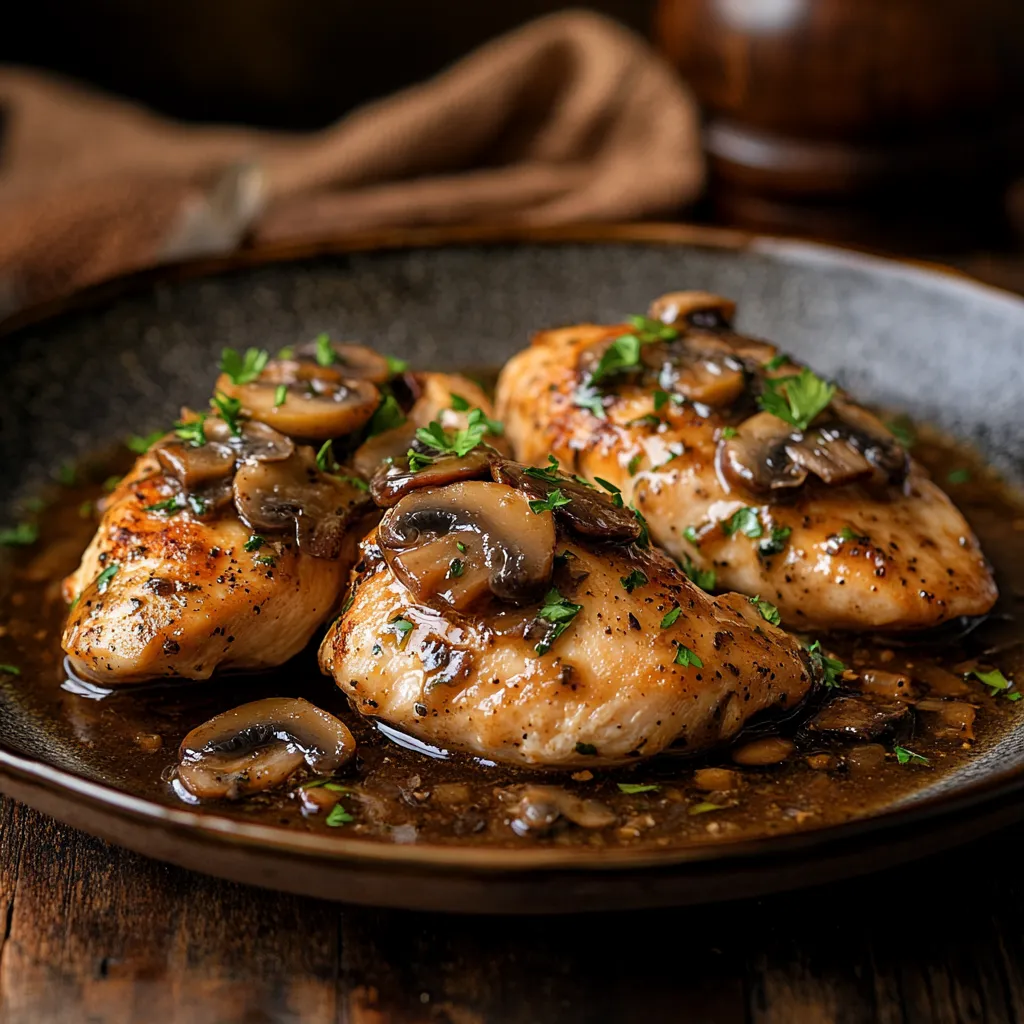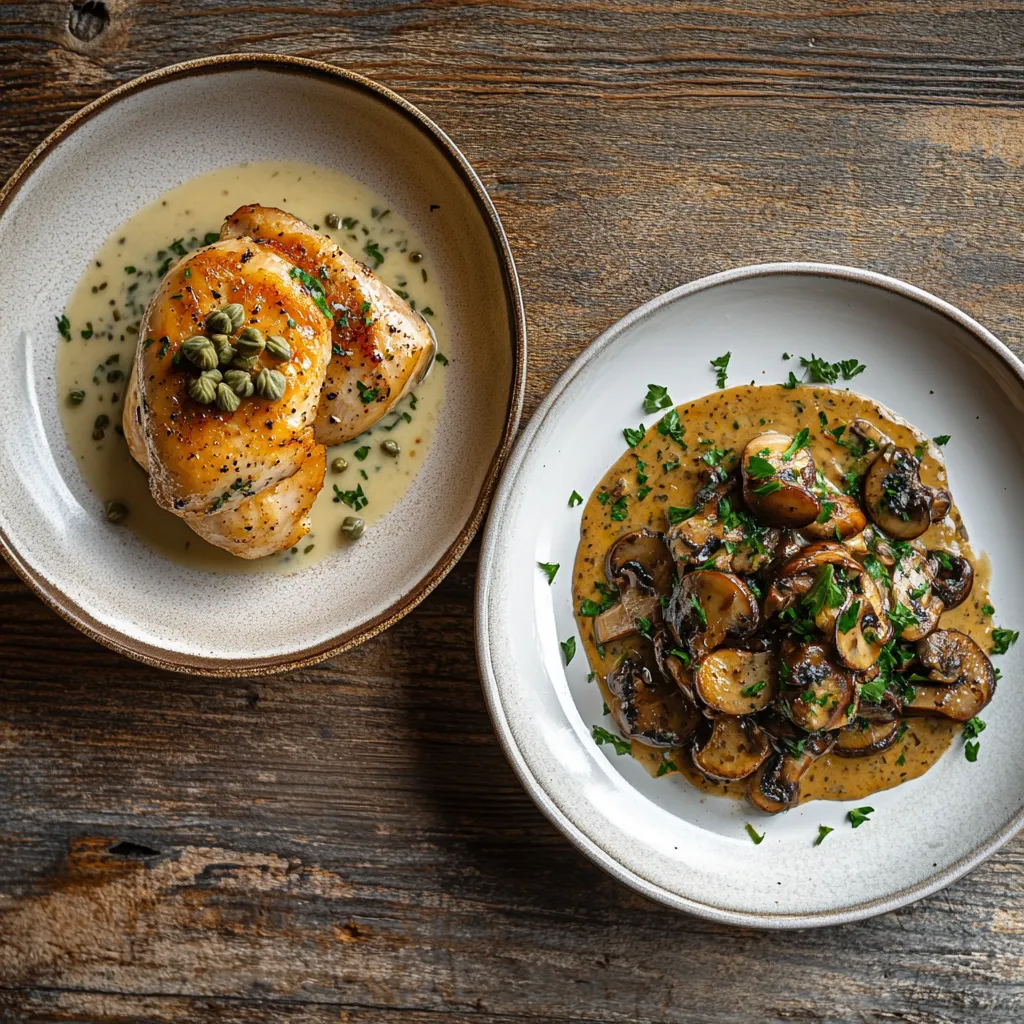Part 1: Introduction
What’s the Difference Between Chicken Piccata and Chicken Marsala?
When it comes to hearty chicken dishes, both Chicken Piccata and Chicken Marsala are beloved for their ability to transform simple ingredients into gourmet meals. Despite their shared heritage in Italian-inspired cooking, these dishes couldn’t be more different in their flavors and presentation.
Chicken Piccata is a celebration of tangy, bright flavors. With a sauce based on lemon juice, butter, and capers, it tantalizes the taste buds with its zesty and fresh notes. In contrast, Chicken Marsala offers a rich, savory experience that leans on the earthy depth of mushrooms and a creamy, slow-simmered sauce.
These differences extend beyond just taste. Their preparation techniques, pairings, and even nutritional profiles differ, giving each dish a specific charm and place on your dinner table. To fully appreciate what each has to offer, let’s delve deeper into their origins and how they’re traditionally prepared.
Part 2: Deep Dive Into Chicken Piccata
What Is Chicken Piccata?
Chicken Piccata is a quintessential dish that celebrates simplicity and freshness. Its name originates from the Italian term piccata, which loosely translates to “larded” or “pounded.” This method emphasizes thinly sliced meat, typically chicken or veal, that is lightly coated, seared, and served with a vibrant, tangy sauce. Though it has roots in Italian cuisine, the version most commonly enjoyed today has been adapted to suit American tastes.

At its core, Chicken Piccata is all about bold and zesty flavors. Lemon juice and capers are the stars of the dish, offering a bright acidity that cuts through the richness of butter or olive oil. While simple in its components, its elegance comes from balancing these flavors harmoniously.
Unique Characteristics of Chicken Piccata
One of the defining traits of Chicken Piccata is its unmistakable tangy flavor profile. The tartness of fresh lemon juice pairs perfectly with the briny, salty notes of capers, creating a sauce that dances on the palate. Garlic and parsley often join the mix, adding depth and a hint of earthiness.
The cooking method for Chicken Piccata also sets it apart. The chicken is typically flattened to ensure even cooking, dredged lightly in flour, and then pan-seared to golden perfection. This process creates a slight crust on the chicken, which absorbs the sauce beautifully. Once the chicken is removed from the pan, the sauce is deglazed and simmered, allowing all the flavors to meld together. The result? A glossy, flavorful sauce that coats the chicken without overwhelming its natural taste.
For presentation, Chicken Piccata is often served with fresh parsley sprinkled on top. This not only enhances its appearance but also complements its citrus-forward flavors. Whether paired with angel hair pasta, rice, or steamed vegetables, it makes for a visually appealing and mouthwatering meal.
Nutritional Value of Chicken Piccata
From a nutritional perspective, Chicken Piccata strikes a balance between indulgence and health-conscious eating. Chicken breast, the dish’s primary protein source, is low in fat and high in lean protein, making it a great option for those watching their caloric intake.
- Calories and Macronutrients: A standard serving of Chicken Piccata provides approximately 250-350 calories, depending on the portion size and cooking method. With minimal use of heavy cream or cheese, it remains a relatively light dish.
- Capers’ Benefits: These tiny, pickled flower buds are not just for flavor—they’re also rich in antioxidants and contain small amounts of fiber.
- Lemon Juice’s Role: Packed with vitamin C, lemon juice adds more than just flavor. It helps support the immune system and aids digestion.
- Healthier Adjustments: For a lighter version, olive oil can be used instead of butter, and a whole-grain flour substitute can replace the all-purpose variety.
Why Choose Chicken Piccata?
Chicken Piccata is a go-to dish for those who crave light and refreshing flavors. It’s perfect for warm weather meals or anytime you want something that feels vibrant and invigorating. Its quick cooking process also makes it an ideal option for weeknight dinners when time is of the essence but flavor is still a priority.
Moreover, its versatility is hard to beat. You can pair it with a variety of sides—think roasted vegetables for a healthier option or buttery mashed potatoes for something indulgent. Its citrus-forward profile even complements a range of beverages, from herbal teas to sparkling water with a twist of lemon.
Modern Twists on Chicken Piccata
While traditional Chicken Piccata sticks to a tried-and-true formula, modern chefs and home cooks alike have put their spin on the classic. Here are a few popular variations:
- Garlic Butter Piccata: Amplifying the richness by incorporating more garlic and butter for a creamy, indulgent twist.
- Vegetarian Piccata: Substituting chicken with tofu, tempeh, or even cauliflower steaks while retaining the tangy sauce.
- Gluten-Free Piccata: Using almond flour or a gluten-free flour blend for dredging.
- Spicy Piccata: Adding crushed red pepper flakes to the sauce for a subtle heat that balances the lemon’s tartness.
Each of these variations maintains the essence of Chicken Piccata while offering something new to the table.
Perfect Occasions for Chicken Piccata
Whether you’re hosting a dinner party or preparing a meal for your family, Chicken Piccata is a dish that shines in virtually any setting. Its ability to feel both elevated and approachable makes it a favorite for everything from casual lunches to elegant dinners. Plus, its refreshing flavor makes it a hit during spring and summer gatherings.
In short, Chicken Piccata isn’t just a dish—it’s an experience. Its tangy, bright, and well-balanced flavors make it a standout option for those who love a touch of citrusy zest in their meals. Let’s now shift gears and explore what makes Chicken Marsala equally unique and delicious.
Part 3: Understanding Chicken Marsala
What Is Chicken Marsala?
Chicken Marsala is a rich, flavorful dish that originates from Italian-American cuisine. Known for its deep, earthy tones and velvety texture, it’s a comforting meal that feels indulgent yet approachable. Unlike its tangy counterpart, Chicken Piccata, this dish leans heavily into savory flavors. The sauce, often thickened naturally through reduction, brings out the best in its ingredients.

Traditionally, Chicken Marsala is made by lightly coating chicken cutlets in flour and then pan-searing them. The real magic, however, lies in the sauce—a combination of sautéed mushrooms, aromatics, and other savory components that simmer together until a beautifully cohesive mixture forms. Each bite feels like a warm, hearty hug for the soul.
Unique Characteristics of Chicken Marsala
One of the defining traits of Chicken Marsala is its earthy and savory flavor profile. While the sauce itself is robust, the addition of mushrooms provides a delightful umami kick that complements the tender chicken. The natural juices released during cooking infuse the dish with depth, creating a flavor-packed sauce that feels luxurious without being overpowering.
The cooking technique emphasizes patience. After pan-searing the chicken, the pan is deglazed to scrape up all the flavorful bits stuck to the bottom—this is where much of the dish’s richness originates. The mushrooms are then sautéed until they release their juices, creating the base for the sauce. As the dish simmers, the flavors meld together, thickening the sauce to the perfect consistency.
While simple in its preparation, Chicken Marsala has a gourmet quality that makes it suitable for both casual family dinners and more formal occasions. It’s an excellent example of how basic ingredients, when prepared thoughtfully, can yield extraordinary results.
Nutritional Value of Chicken Marsala
Despite its rich flavor, Chicken Marsala can be surprisingly balanced in terms of nutrition.
- Calories and Macronutrients: A single serving typically contains around 300-400 calories, depending on portion size and preparation methods. The absence of heavy cream keeps the calorie count moderate.
- Mushroom Benefits: Mushrooms are a standout ingredient in Chicken Marsala. They’re low in calories, rich in fiber, and packed with antioxidants, making them a healthy addition to the dish.
- Protein Content: Like Chicken Piccata, the chicken breast serves as a lean protein source that’s low in fat and high in nutritional value.
- Healthier Swaps: For a lighter version, olive oil can replace butter, and additional vegetables like spinach can be added to increase the dish’s fiber and vitamin content.
Why Choose Chicken Marsala?
If you’re someone who enjoys meals with complex flavors and hearty textures, Chicken Marsala is a stellar choice. Its savory and umami-rich profile makes it perfect for cooler weather or when you’re craving something satisfying and comforting.
What’s more, its versatility in pairings makes it an adaptable meal. While it pairs beautifully with pasta, it’s just as delightful alongside roasted potatoes, sautéed green beans, or a simple side salad. The balance of richness and earthy tones allows it to shine on its own or serve as the centerpiece of a larger meal.
Modern Twists on Chicken Marsala
While the classic version remains timeless, creative chefs and home cooks have found ways to reinvent Chicken Marsala to cater to diverse tastes.
- Vegetable Marsala: Substituting chicken with hearty vegetables like eggplant or zucchini for a vegetarian-friendly option.
- Lighter Marsala: Using less butter and focusing on additional vegetables to make the dish lower in fat.
- Herb-Infused Variations: Adding fresh thyme or rosemary for an aromatic twist.
- Dairy-Free Marsala: Skipping butter altogether and using plant-based oils to make the dish accessible for those with dietary restrictions.
Each variation offers a new way to enjoy the dish while retaining its signature richness.
Perfect Occasions for Chicken Marsala
Thanks to its warm and comforting flavor, Chicken Marsala is an excellent choice for dinners when you want to impress your guests without the hassle of an overly complicated recipe. It’s also a great make-ahead meal since the sauce often tastes better the next day as the flavors continue to deepen.
Its rustic yet elegant appeal makes it equally at home on a weeknight dinner table or as part of a celebration spread. Whether served with creamy mashed potatoes, fluffy rice, or crisp roasted vegetables, Chicken Marsala adds a sense of warmth and satisfaction to any meal.
Now that we’ve explored both dishes in detail, it’s time to compare them side by side and uncover the unique factors that set Chicken Piccata and Chicken Marsala apart.
Part 4: Comparing Chicken Piccata and Chicken Marsala
Key Differences Between Chicken Piccata and Chicken Marsala
While both dishes feature chicken as the main ingredient, their flavor profiles, preparation methods, and ideal pairings set them apart.
- Ingredients:
Chicken Piccata relies on lemon juice, capers, and a light butter sauce for its signature tangy flavor. In contrast, Chicken Marsala is defined by its earthy ingredients, such as mushrooms, and its rich, savory sauce. These unique components give each dish a distinct taste. - Flavor Profile:
Piccata is bright, zesty, and refreshing—a perfect choice for those who love citrus-forward dishes. Marsala, on the other hand, is warm, hearty, and comforting, offering a richer and more complex taste. - Appearance:
With its vibrant yellow sauce and green caper garnish, Chicken Piccata is visually light and fresh. Marsala’s darker sauce, thanks to mushrooms and slow simmering, reflects its bold, earthy flavors.
Cooking Techniques Compared
The preparation of these dishes also differs:
- Chicken Piccata involves pan-searing chicken until lightly golden and simmering it briefly in a lemon-butter sauce. The focus is on maintaining the dish’s brightness and delicate balance.
- Chicken Marsala requires a slightly longer cooking time, as the sauce thickens through reduction. The mushrooms are sautéed until tender, adding to the dish’s depth and richness.
Each technique plays a crucial role in enhancing the respective dish’s flavors, making the cooking method as important as the ingredients themselves.
When to Choose Chicken Piccata vs. Chicken Marsala
Deciding between the two often depends on personal taste and occasion.
- Choose Chicken Piccata if:
You’re looking for a lighter, tangy dish that pairs well with summer vegetables, crisp salads, or pasta with olive oil. Its citrus-forward profile is ideal for warm weather or when you want something refreshing. - Choose Chicken Marsala if:
You’re in the mood for something heartier with deeper flavors. Marsala pairs beautifully with creamy sides like mashed potatoes, roasted vegetables, or rich pasta dishes, making it perfect for colder months or special occasions.
Popular Variations of Both Dishes
Both dishes have been reimagined in various ways:
- Piccata variations may include a creamy sauce or even seafood substitutes like shrimp.
- Marsala variations often add herbs or additional vegetables for a unique twist.
Whether you prefer the tangy brightness of Chicken Piccata or the savory depth of Chicken Marsala, both are delicious testaments to Italian-American culinary ingenuity.
FAQs About Chicken Piccata and Chicken Marsala
What makes Chicken Piccata tangy?
The tangy flavor in Chicken Piccata comes primarily from its lemon juice base. Combined with the briny, salty taste of capers and the richness of butter, this dish delivers a zesty and vibrant flavor that stands out.
Can you substitute other ingredients for capers in Chicken Piccata?
Yes, if you don’t have capers on hand or prefer a milder flavor, you can use green olives or pickled green peppercorns. They offer a similar briny taste, though capers are traditional for this dish.
Which is healthier: Chicken Piccata or Chicken Marsala?
Chicken Piccata is typically lighter because it doesn’t rely on heavy, creamy sauces. Its base of lemon juice and light butter makes it lower in calories and fat compared to Chicken Marsala. However, both can be adjusted to suit specific dietary needs.
What sides pair well with Chicken Piccata and Chicken Marsala?
- Chicken Piccata pairs wonderfully with pasta tossed in olive oil, steamed vegetables, or rice pilaf.
- Chicken Marsala is excellent with creamy mashed potatoes, roasted asparagus, or a crusty bread to soak up the sauce.
Are there vegetarian versions of Chicken Piccata and Chicken Marsala?
Absolutely! For Chicken Piccata, tofu or cauliflower steaks can be used as substitutes for chicken. Similarly, for Chicken Marsala, hearty vegetables like eggplant or portobello mushrooms work well in place of chicken.
How do you store and reheat these dishes?
Both dishes can be stored in an airtight container in the refrigerator for up to 3 days. Reheat on the stove over low heat, adding a splash of broth or water to keep the sauce from drying out. Avoid microwaving, as it may alter the texture of the chicken and sauce.
Conclusion
In the end, Chicken Piccata and Chicken Marsala each bring something special to the table. Piccata’s tangy and bright flavors contrast beautifully with Marsala’s rich and hearty profile, offering options for any mood or occasion. Whether you prefer the zesty kick of lemon or the earthy depth of mushrooms, exploring these dishes is a culinary journey worth taking. Whichever you choose, you’re sure to enjoy a meal that’s as delicious as it is satisfying!

